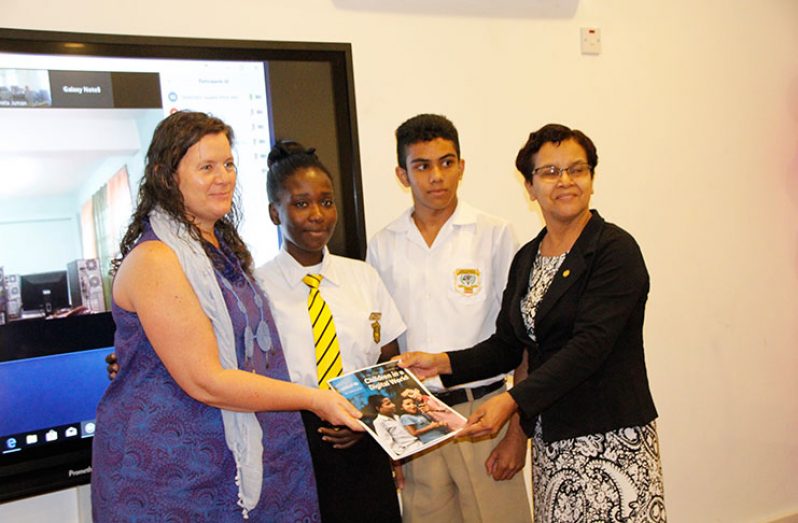— at launch of UNICEF State of the World’s Children Report
THE negatives and positives of technology were put under the spotlight at the launch of The State of the World’s Children 2017 Report at the National Centre for Educational Resource Development (NCERD) on Tuesday.
The report prepared by the United Nations International Children’s Fund (UNICEF) looks at issues affecting children around the world, and according to Sylvie Fouet, UNICEF representative, this year’s theme for the report for Guyana and Suriname is “Children in a Digital World”.
The report highlights both the benefits and challenges of digital technology and looks at how digital technology is impacting the lives of people, especially children. Digital technology, Fouet said, can be a game-changer.
Technology provides opportunities for learning and allows platforms to be connected and used to communicate globally.
During the launch, eight schools from the 10 administrative regions were connected live using the Smart Classroom at NCERD.
The UNICEF representative said she is looking forward to seeing children in the hinterland connect with their colleagues on the coastland to learn from each other, share information and ideas.
Aside from the positives, Fouet pointed out that excessive use can lead to depression and anxiety in children.
As such, use of technology must be moderate, she warned, noting that the impact of technology can be a challenge in some instances.
NCERD Director, Jennifer Cumberbatch said the embrace of digital technology by the education sector will allow children to learn a lot more.
Meanwhile, Ministry of Education ICT Coordinator, Marcia Thomas informed those in attendance of the importance technology in providing equal opportunities in education.
It is a tool to bridge the gap between the hinterland, rural and coastal regions and the Smart Classroom is a way forward in the delivery of education. One feature of the Smart Classroom is that the E-Station monitors the devices that are used by students to connect to the system. This way, the tutor can know what each child is doing with the device and ensure that it is being used correctly during periods of instruction.
This is bolstered by the classroom management software called “Radix”. With this software, teachers can record lessons and students can participate in the live recordings. However, for students who might have missed the live lessons, they can access the recordings for as long as one month.
Access to these materials will be facilitated through an App called “Smart Class Guyana” that will be available in Google Play Store and on Apple App Store.
Following the speeches and presentations, students from the outlying schools that were viewing the launch from their Information Technology labs said technology plays an important role in their school life in terms of assistance to complete work and to learn about foreign cultures, which boosts their tolerance of others.
The students were also shown videos that taught them about the dangers and benefits of technology.
The UNICEF SOWC report was handed over to the Ministry of Education. The ministry was represented by acting Deputy Chief Education Officer, Ingrid Trotman.
Also present at the launch were other UNICEF representatives, the diplomatic corps and students and teachers from the North Ruimveldt Multilateral School and Queen’s College.



.jpg)








